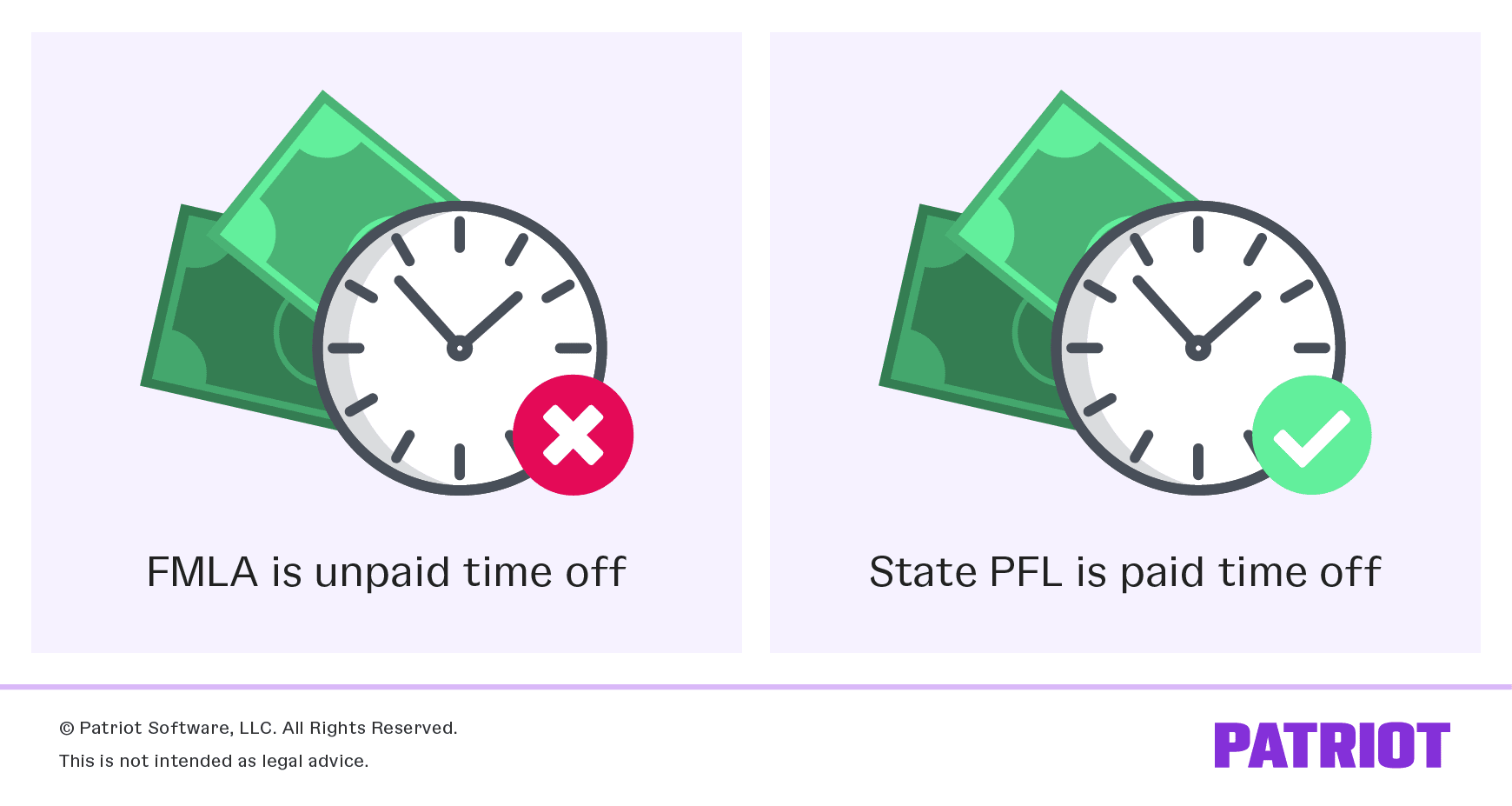According to the most recent BLS data, 27.5% of workers have access to paid family leave. Do yours? If you do business in one of the states with paid family leave laws, the answer should be yes.
So, what is paid family leave? Which states require it? And, how do state leave laws compare with the federal Family and Medical Leave Act? Get your questions answered below.
What is paid family leave?
Paid family leave (PFL), or paid family and medical leave (PFML), is a state-mandated law that provides employees with paid family and medical leave. States with paid family leave require employees and/or employers to contribute to a paid leave fund. Eligible employees who work in states with state family and medical leave laws receive wages when they take off from work for qualifying reasons.
In most (but not all) cases, family and medical leave are lumped together under one law. But, there’s a difference between the two:
- Paid family leave: Time away from work employees can spend bonding with a new child or taking care of ill family members
- Paid medical leave: Time away from work employees can take to care for their own serious illness
If you’re an employer with employees who work in one of the states with paid family leave, you need to know your responsibilities.
Keep in mind that paid family leave is different from paid sick leave. Paid sick leave is time off an employee can use if they are out sick. A number of states have paid sick leave laws.
State family leave vs. federal family leave
The Family and Medical Leave Act (FMLA) is a federal law that requires businesses with at least 50 employees to provide unpaid leave. FMLA guidelines for employers apply to qualifying businesses in all states.
Under federal law, employees can take leave for:
- The birth, adoption, or foster care placement of a child
- The care of a spouse, child, or parent with a serious health condition
- A personal serious health condition that makes the employee unable to perform their job
- A situation that requires attention because of the military deployment of a spouse, child, or parent
The main difference between federal and state FMLA laws is whether the leave is paid or unpaid. Federal family leave is unpaid. State family leave is paid.

State law generally requires employees, employers, or both to pay into a fund. You must deduct and/or contribute a standard percentage of an employee’s wages to fund paid family and medical leave. Because federal FMLA is unpaid, you don’t have to worry about these types of payroll deductions.
States with paid family leave
So, what states have paid family leave? The following have state leave laws:
- California
- Colorado
- Connecticut
- D.C.
- Delaware
- Maine
- Maryland
- Massachusetts
- Minnesota (coming soon!)
- New Hampshire (voluntary)
- New Jersey
- New York
- Oregon
- Rhode Island
- Vermont (voluntary)
- Washington
Some cities, like San Francisco, also require paid family leave. And, some states have an unpaid family leave law (e.g., Hawaii).
The states with state-mandated paid family leave set specific rules about:
- Reasons for paid leave
- How long employees can take paid leave
- Which employees qualify for leave
- Who pays
- Contribution rate
If you must provide paid family leave to your employees, notify your employees and post a notice in your workplace.
Read on for a detailed overview of the paid family leave laws by state.
California paid family leave
California’s Paid Family Leave was the first program implemented in the country. If you’re an employer in California, you do not need to contribute to the state’s paid family leave program. However, you must withhold contributions from your employees’ wages for the employee-funded program.
California’s PFL is part of its State Disability Insurance (SDI) Program. Here’s what you need to know about it:
- Reasons for paid leave: Employees can take paid family leave to:
- Care for a seriously ill family member
- Bond with a new child (birth, adoption, or foster care)
- Participate in a qualifying event due to a family member’s military deployment to a foreign country
- How long employees can take paid leave: Up to eight weeks within any 12-month period
- Which employees qualify for leave: Workers who are “attached to the labor market” (e.g., employed), have wage loss due to the leave, and have sufficient earnings in the previous 12-month period
- Who pays: Employees
- Contribution rate: 1.2% of employee wages (a combined rate for both state disability insurance and paid family leave)
Check out California’s website for more information on paid family leave.
Colorado paid family leave
Here’s what you need to know about Colorado’s paid family leave:
- Reasons for paid leave: Employees can take Colorado paid family leave if they:
- Have given birth
- Need to deal with a serious health condition
- Must care for a seriously ill family member
- Need to take safe leave due to domestic violence
- How long employees can take paid leave: 12 weeks, plus four additional weeks if the employee has medical complications
- Which employees qualify for leave: Employees who have earned at least $2,500 at their job
- Who pays: Employees and employers
- Contribution rate: 0.9%, split 50/50 between employees and employers; businesses with fewer than 10 employees are exempt from employer portion
For more information on Colorado’s upcoming state family leave law, contact the state.
Connecticut paid family leave
Connecticut’s Paid Family and Medical Leave Act (PFMLA) program began in January 2021.
Here’s the scoop on the Connecticut paid family leave program:
- Reasons for paid leave: Employees can take paid family leave to:
- Deal with a health condition or injury
- Care for a seriously ill family member
- Bond with a new child (birth, adoption, or foster care)
- Take more time for recovery during pregnancy or after childbirth (can apply for an extra 2 weeks of leave)
- Donate bone marrow or an organ
- Participate in a qualifying event due to a family member’s military deployment to a foreign country
- Deal with a situation related to the military deployment of a family member
- Handle situations related to family violence
- How long employees can take paid leave: 12 weeks in a 12-month period (plus 2 additional weeks for pregnancy or childbirth recovery)
- Which employees qualify for leave: Full-time and part-time employees who earned at least $2,325 in the highest-earning quarter of the first four of the past five quarters and is working in the state or has worked in Connecticut during the past 12 weeks
- Who pays: Employees
- Contribution rate: 0.5% of employee wages
Head on over to Connecticut’s website for more information.
D.C. paid family leave
D.C.’s Paid Family Leave program is employer-only, meaning you do not withhold premiums from employee wages. You must pay this premium if you are covered by the D.C. Unemployment Compensation Act.
Here’s what the Washington D.C. paid family leave program entails:
- Reasons for paid leave: Employees can take paid family and medical leave to:
- Bond with a new child (up to 8 weeks)
- Care for a seriously ill family member (up to 6 weeks)
- Deal with a serious health condition or in the event of a stillbirth or miscarriage (up to 6 weeks)
- Take prenatal medical care leave, including appointments, exams, and treatments (up to 2 weeks before the birth of a child)
- How long employees can take paid leave: Duration depends on reason for time off
- Which employees qualify for leave: Employees who worked for an employer in D.C. before needing to take PFL
- Who pays: Employers
- Contribution rate: 0.75% of each employee’s wages
For more information about this family leave program, check out Washington D.C.’s website.
Delaware paid family leave
Delaware’s Healthy Delaware Families Act (the Act) went into effect in 2025. Employer contributions began in 2025, and employees can start applying for benefits in 2026.
Although it’s a few years away, here’s what you need to know about Delaware paid family leave:
- Reasons for paid leave: Employees can use Delaware PFL to:
- Bond with a new child
- Care for a serious health condition
- Care for a family member (i.e., spouse, parent, or child) with a serious health condition
- Address the impact of a family member’s military deployment
- How long employees can take paid leave: Up to 12 weeks per year
- Which employees qualify for leave: Delaware employees who work at least 1,250 hours for a covered employer in the preceding 12 months
- Who pays: Employers and employees
- Contribution rate: 0.8% funded by employer, but employers can require employees pay half the cost
For more information about Delaware’s upcoming PFML program, check out Delaware’s website.
Maine paid family leave
On July 11, 2023, Maine’s governor signed into law the state’s paid family and medical leave program. Payroll contributions for Maine’s PFML begin January 1, 2025, and benefits begin in mid-2026.
Take a look at the following information about the upcoming law:
- Reasons for paid leave: Employees can use Maine Paid Family and Medical Leave to:
- Bond with a child after birth, adoption, or foster care
- Care for a family member with a serious health condition or who is a covered service member
- Attend to a qualifying exigency
- Take safe leave
- Other (e.g., organ donation)
- How long employees can take paid leave: Up to 12 weeks per year
- Which employees qualify for leave: Full- and part-time employees who earned at least six times the state average weekly wage in the year before taking leave
- Who pays: Employees, and employers with 15 or more employees
- Contribution rate:
- 15 or more Maine employees paid in 20 or more of the weeks: 1.0%, and you may withhold up to half of the premium from your employees’ wages
- Fewer than 15 qualifying Maine employees: 0.5%, and you may withhold all or part of the contribution from your employees
Check out Maine’s website for more information on the state’s paid family leave program.
Maryland paid family leave
Employer contributions begin in 2024, and employees can begin applying for benefits in 2026.
Here’s the scoop on Maryland paid family leave:
- Reasons for paid leave: Employees can use Maryland Family and Medical Leave to:
- Care for a newborn child or a child newly placed for adoption, foster care, or kinship care
- Care for a family member with a serious health condition
- Deal with a serious health condition that prevents them from performing the functions of their position
- Care for a military service member with a serious health condition resulting from military service
- Deal with a family member being on active duty
- How long employees can take paid leave: Up to 12 weeks per year (or up to 24 weeks in some situations)
- If an employee takes leave for both the birth or placement of a child and for a serious health condition, the employee can take a maximum of 24 weeks
- Which employees qualify for leave: Maryland employees who work at least 680 hours over the preceding 12-month period that the employee would receive paid leave (includes part-time and full-time employees)
- Who pays: Employees, plus employers with 15 or more employees and employees
- Contribution rate: 0.9%
You can check out more information on Maryland’s new program here.
Massachusetts paid family leave
Massachusetts Paid Family Medical Leave (PFML) is an employee and employer program. All employees must contribute. Employers with 25 or more employees must also contribute.
Check out our rundown on Massachusetts PFML:
- Reasons for paid leave: Employees can use PFML to:
- Bond with a child during the first 12 months after the child’s birth, adoption, or foster care placement
- Care for a seriously ill family member
- Deal with a serious health condition
- Care for a military family member who developed or aggravated a serious condition while deployed to a foreign country
- Deal with a family member being on active duty
- How long employees can take paid leave: Up to 26 weeks per year
- Which employees qualify for leave: Full-time and part-time employees working in Massachusetts
- Who pays: Employees, and employers with 25 or more employees
- Contribution rate: 0.88% of employee wages, split between employee and employers with 25 or more employees; 0.46% of employee wages for employers with fewer than 25 covered individuals
View Massachusetts’ website for more information on paid family leave.
Minnesota PFL
The Paid Family and Medical Leave program for Minnesotans will launch in 2026. This upcoming law applies to all employers, regardless of size.
- Reasons for paid leave: Employees can use PFML to:
- Care for a family member with a serious health condition
- Bond with a new baby or child in the family
- Deal with a personal serious health condition that prevents work
- Support a family member in the military deploying overseas
- Deal with a significant personal safety issue that the employee or a family member is facing
- How long employees can take paid leave: Up to 12 weeks of work per year for a single qualifying event (medical or family leave); up to 20 weeks of combined medical and family leave if the employee has more than one qualifying event in the same claim year
- Which employees qualify for leave: Employees who experience a qualifying event and have earned more than the state threshold
- Who pays: Employers and employees
- Contribution rate: TBD
You can check out the Minnesota Employment and Economic Development site for more information.
New Hampshire paid family leave
New Hampshire’s Granite State Paid Family Leave Plan is a voluntary program employers and/or employees can choose to participate in. Employers can receive a tax credit for opting in. If employers do not opt in to the program, employees can join on an individual basis.
- Reasons for paid leave: Employees can take paid leave to:
- Bond with a newborn, newly adopted child, or newly placed foster child within the first year
- Care for a spouse, child, or parent with a serious health condition
- Care for a spouse, child, or parent in the military
- Deal with a personal serious health condition if employer does not offer short-term disability insurance
- How long employees can take paid leave: Up to 6 weeks of work per year
- Which employees qualify for leave: Up to the commissioner, who can set a tenure requirement and waiting period
- Who pays: Employers and employees (voluntary)
- Contribution rate: Varies
For more information, check out New Hampshire’s website.
New Jersey PFL
New Jersey’s Family Leave Insurance program is funded by employees only. Take a look at the program basics:
- Reasons for paid leave: Employees can take paid leave to:
- Bond with a newborn, newly adopted child, or newly placed foster child
- Care for a seriously ill or injured family member
- How long employees can take paid leave: Up to 12 weeks (consecutive) or 8 weeks (non-consecutive) in a 12-month period
- Which employees qualify for leave: Employees who worked 20 weeks earning at least $240 weekly or earned a combined total of $12,000 in the first four of the last five completed quarters
- Who pays: Employees
- Contribution rate: 0.33% of employee wages up to the wage base
For more information, check out New Jersey’s website.
New York paid family leave
New York’s Paid Family Leave is an employee-only program. As an employer, you do not need to pay into the PFL fund.
Check out the basics of New York paid family leave:
- Reasons for paid leave: Employees can use New York PFL to:
- Bond with a newly-born, adopted, or fostered child
- Care for a close relative with a serious health condition
- Assist when a family member is deployed abroad on active military service
- How long employees can take paid leave: Up to 12 weeks of leave
- Which employees qualify for leave: Employees who work 26 consecutive weeks (working 20 or more hours per week) or 175 days in a year (working less than 20 hours per week)
- Who pays: Employees
- Contribution rate: 0.388% of employee wages, up to the wage base
Want more New York PFL details? Consult New York’s state website for the scoop.
Oregon PFL
Oregon’s Paid Family and Medical Leave Insurance (PFMLI) program started in 2023 with employee and employer payroll contributions.
Here’s what to know about Oregon paid family leave:
- Reasons for paid leave: Employees can take PFMLI to:
- Bond with a child (birth, adoption, or foster care placement)
- Care for a seriously ill family member
- Deal with a serious health condition
- Take safe leave due to domestic violence, harassment, sexual assault, or stalking
- How long employees can take paid leave: Up to 12 weeks, plus an additional 2 weeks for pregnancy, childbirth, and related circumstances
- Which employees qualify for leave: Employees who earned $1,000 or more in the previous year
- Who pays: Employees and employers with 25 or more employees
- Contribution rate: 1.0%, shared between employees (60%) and employers with 25 or more employees (40%)
For more information on Oregon’s PFMLI, head over to the state website.
Rhode Island PFML
Rhode Island’s paid family and medical leave program is divided into two parts:
- Temporary Disability Insurance (TDI): Employees can use to care for their own illness or injury
- Temporary Caregiver Insurance (TCI): Employees can use to care for a new child or family member
Here’s a little bit more background on the Rhode Island program:
- Reasons for paid leave: Employees can use TDI and TCI to:
- Bond with a child (birth, adoption, or foster care placement)
- Care for a seriously ill family member
- How long employees can take paid leave: Employees can take TCI for up to 5 weeks and TDI for up to 30 weeks
- Which employees qualify for leave: Employees must be out of work for at least 7 days due to qualifying reasons before receiving TDI or TCI benefits
- Who pays: Employees
- Contribution rate: 1.3% of employee wages up to wage base (includes both TDI and TCI)
For more information about Rhode Island’s program, check out their website.
Vermont paid family leave
Beginning July 1, 2024, Vermont’s private sector employers can participate in the state’s voluntary paid family and medical leave insurance program (VT FMLI).
Vermont’s paid family and medical leave insurance program will be administered by The Hartford. Here is a brief overview of the upcoming program:
- Reasons for paid leave: Employees can take paid leave to:
- Bond with a new child (baby, adoption, foster care placement)
- Deal with a serious health condition
- Care for a family member
- Deal with a qualifying exigency where the employee’s spouse, son, daughter, or parent is a covered military member on “covered active duty”
- Take military caregiver leave to care for a covered service member with a serious injury or illness
- How long employees can take paid leave: Up to 6 weeks in a 12-month period
- Contribution rate: Varies; employers can purchase insurance from The Hartford
You can learn more about Vermont’s voluntary paid FMLI program here.
Washington paid family leave
If you’re a Washington employer, withhold the Washington Paid Family & Medical Leave premium from employee wages. If you have 50 or more employees, you must also contribute an employer portion.
Here’s the scoop:
- Reasons for paid leave: Employees can take paid leave to:
- Bond with a new child (baby, adoption, foster-care placement)
- Deal with a serious illness or injury
- Care for a seriously ill family member
- Spend time with a family member who is about to be deployed overseas or is returning from overseas deployment
- How long employees can take paid leave: Up to 12 weeks; up to 16 weeks for employees with more than one qualifying event; up to 18 weeks for employees who experience a pregnancy or birth condition that incapacitates them
- Which employees qualify for leave: Workers who have worked a minimum of 820 hours during the previous year
- Who pays: Employees and employers with 50 or more employees
- Contribution rate: 0.92% of employee wages, shared by employee (71.52%) and, if applicable, employer (28.48%), up to the Social Security wage base
If you have questions about the program, view Washington’s website.
State-mandated paid family leave and payroll
As an employer, you must accurately withhold deductions, like state-mandated paid family leave, and taxes from an employee’s wages.
So, which comes first? Do you withhold taxes before or after you deduct PFL premiums?
PFL premiums are post-tax deductions. This means you withhold taxes before you deduct state premiums from employee wages.
To keep contribution rates and contributors straight, use our states with paid family leave chart:
| State | Who Contributes PFL Premium? | Total PFL Contribution Rate |
|---|---|---|
| California | Employees | 1.2% |
| Colorado | Employees & Employers | 0.9% |
| Connecticut | Employees | 0.5% |
| D.C. | Employers | 0.75% |
| Delaware | Employees & Employers | 0.8% |
| Maine | Employees & Qualifying Employers | 1.0% |
| Maryland | Employees & Qualifying Employers | 0.9% |
| Massachusetts | Employees & Qualifying Employers | 0.88% |
| Minnesota | Employees & Employers | TBD |
| New Hampshire | Voluntary: Employees & Employers | Varies |
| New Jersey | Employees | 0.33% |
| New York | Employees | 0.388% |
| Oregon | Employees & Qualifying Employers | 1.0% |
| Rhode Island | Employees | 1.3% |
| Vermont | Voluntary: Employers | Varies |
| Washington | Employees & Qualifying Employers | 0.92% |
Calculating state-mandated paid family leave doesn’t have to consume your time. Use Patriot’s payroll software to calculate and withhold state paid family leave premiums from employee wages. Start your free trial today to find out what you could do with the time you save!
This article has been updated from its original publication date of June 17, 2019.
This is not intended as legal advice; for more information, please click here.



